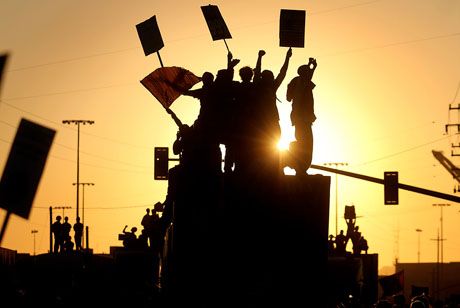Features
You are here
College teachers: good deal or bad deal?

October 5, 2012
College teachers in Ontario with a contract ending on August 31 looked like they would be getting the same hammering by Dalton Mcguinty as public school teachers but on the eve of a strike vote the employer pulled every concession off the table and agreed to a significant union demand—job security for partial load teachers (8-12 teaching hours).
Still left in the deal that college teachers ratified (88 per cent) was a two-year wage freeze. Some are saying that a deal with the wage freeze, a much trumpeted demand by McGuinty of all public sector workers, is a bad deal. With every concession off the table and a job security gain by a section of part time workers this has to be looked at more closely.
Understanding the broader context of austerity and the specific situation on the ground is key to interpretation. Like the Rio Tinto workers in Alma if we just look at the deal from the outside we miss the dynamic that determines the subjective attitudes of the workers.
What the employer wanted and what they got
If we look at what the employer wanted and what the employer got then it is clear that the employer did not get what they were pushing for. Bargaining since June, the employer was asking for concessions on sick days and most worrying a new category of teacher—”facilitator,” with low pay, no job security or benefits. This would undermine the Standard Workload Formula (SWF) that is the foundation of the collective bargaining teachers have negotiated over decades.
This is what the employer really was after and would continue the erosion of the SWF that has been going on in the last two rounds of bargaining. After acrimonious bargaining the sick day concession and “facilitator” category came off the table. The employer did not get what they wanted.
Partial load job security gain
Partial load (PL) teachers teach 8-12 hours and are in the bargaining unit. They have pay equivalency and minimal benefits but no job security. The employer has been hiring more faculty in this category instead of creating full time jobs so the number has been rising in relation to full time teachers. In the last two rounds of bargaining the union has attempted to get something for these teachers. The employer has flatly refused to discuss PL issues.
In a sudden turn around to get a deal following the setting of a strike vote date, the employer agreed to accept partial load job security language if the teachers took the wage freeze.
The question of wages has been a lower priority demand than issues related to the SWF and PL teachers. Although, there was a modest wage increase in the union demands this was not the big issue. The wage freeze also does not effect the seniority step progression.
College teachers bargaining strategy
In 2010, college teachers were the first public sector workers in Ontario to face an imposed contract. An unprecedented move at that time, it produced a kind of ‘shock and awe’ response from teachers and the union. Fear engendered by the economic crisis and anticipated public perception of a strike cowed the teachers into voting for a concessions contract.
This shook up the union and the process for the 2012 round of bargaining was tightened and democratized. Demands went from 360 in the previous round of bargaining to 28. Messaging from the bargaining team was clear and concise. The bargaining team rightly identified the “facilitator” demand as the employer’s main goal even though it would only effect one department, nursing.
Social media was employed extensively to inform members and bargaining team members attended multiple face to face meetings with college locals. A big difference from 2010.
Strike vote and sudden turnaround
When negotiations stalled over the issue of the “facilitator” in August, the union filed for conciliation and the employer followed with a “no-board.” The no-board set the stage for a repeat of the previous round of bargaining. The employer could lock-out or impose (as they did in 2010). The union then set a strike vote date.
The bargaining team had signaled early on the need for a strike vote if negotiations did not go well. The example of the Toronto city workers was raised as a cautionary tale. When the strike vote was called the bargaining team proactively promoted it to members with videos and printed information.
With teachers just beginning to return to work it would be a scramble but strike vote preparation went into full gear. With a decreasing number of full time faculty compared to contract faculty and the legacy of a weak strike vote in 2010 with teachers eventually voting for the concessions imposed by the employer it was not looking promising to many activists that there would be a strong mandate out of a strike vote, even with much better messaging and preparation.
This was the situation when the bargaining team was contacted by the employer with a take it or leave it deal. Every concession was taken off the table leaving only a two-year wage freeze. The bargaining team said yes if job security language for partial load and another demand related to supervision was accepted. The employer agreed and the bargaining team with the approval of local execs accepted the deal—all of this in a matter of a few hours after months of acrimonious bargaining.
Why the shift
Most activists and the bargaining team were taken completely by surprise and many people wondered what the catch would be. There are many possible explanations that all may have contributed to this outcome. The Ontario Liberals were facing by elections that could have given them a majority. The employer had faced a strike at the beginning of the previous school year by support staff and administrators were balking at dealing with a similar situation.
Critically, the union responded to the employer’s push for concessions and the possibility of a lock-out or imposition with a strike vote and they were ready to push for gains when the opportunity arose. Whatever the reasons for turnaround it was important that the union had demands ready to go and was willing to call the strike vote to pressure the employer.
The Outcome
Even with the wage freeze there was a general sense that we “dodged a bullet.” But despite this there was disagreement even among the bargaining team about how to characterize this outcome. Some the bargaining team members were calling it a bad deal even though they were pleased to have gotten the partial load language. Some were hoping the ratification vote would be close. It was not.
There was also the feeling among some bargaining team members and local exec people that because the damage is light and there is something positive in this round of bargaining, it is the opportunity to mobilize before the next round when there is the expectation concessions will be back on the agenda.
It is for this reason this deal needs to be characterized as a good outcome. Although it did not happen because of mass teacher pressure, the end result is that the activists are feeling buoyed by not being pushed backward after being bullied in the last round of bargaining. Plus, the bright spot of a gain for some teachers that putting winds in the sails of those who see this as an opportunity to strengthen the union.
Context of austerity
McGuinty has been loudly trumpeting the across the board wage freeze as his main austerity demand from the public sector. But a look at the newly passed legislation, Bill115, shows what the underlying agenda is as much union-busting as saving money. The bill which is directed at public school teachers not only imposes a contract and takes way the right to strike it blocks every avenue of negotiation or challenge that could be raised. It is a chilling piece of legislation that while it might not stand a legal challenge (à la Wisconsin) creates a climate of fear and intimidation.
In this context the wage freeze was less significant downside than concessions would have been for the morale of activists and making a gain for partial load teachers is an opportunity for the union to build.
Section:
- Log in to post comments










